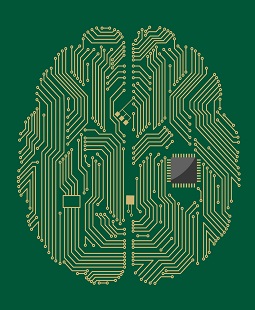
Spaun, a new software model of a human brain, is able to play simple pattern games, draw what it sees and do a little mental arithmetic. It powers everything it does with 2.5 million virtual neurons, compared with a human brain's 100 billion. But its mistakes, not its abilities, are what surprised its makers the most, said Chris Eliasmith, an engineer and neuroscientist at the University of Waterloo in Canada.
 Ask
Spaun a question, and it hesitates a moment before answering, pausing for about
as long as humans do. Give Spaun a list of numbers to memorize, and it falters
when the list gets too long. And Spaun is better at remembering the numbers at
the beginning and end of a list than at recalling numbers in the middle, just
like people are.
Ask
Spaun a question, and it hesitates a moment before answering, pausing for about
as long as humans do. Give Spaun a list of numbers to memorize, and it falters
when the list gets too long. And Spaun is better at remembering the numbers at
the beginning and end of a list than at recalling numbers in the middle, just
like people are.
"There
are some fairly subtle details of human behavior that the model does
capture," said Eliasmith, who led the development of Spaun, or the
Semantic Pointer Architecture Unified Network. "It's definitely not on the
same scale [as a human brain]," he told TechNewsdaily. "It gives a
flavor of a lot of different things brains can do."
Eliasmith
and his team of Waterloo neuroscientists say Spaun is the first model of a
biological brain that performs tasks and has behaviors. Because it is able to
do such a variety of things, Spaun could help scientists understand how humans
do the same, Eliasmith said. In addition, other scientists could run simplified
simulations of certain brain disorders or psychiatric drugs using Spaun, he
said.
A brain with thought
and action
Researchers
have made several brain models that are more powerful than Spaun. The Blue
Brain model at the Ecole Polytechnique Fédérale de Lausanne in France has 1
million neurons. IBM's SyNAPSE project has 1 billion neurons. Those
models aren't built to perform a variety of tasks, however, Eliasmith said.
Spaun
is programmed to respond to eight types of requests, including copying what it
sees, recognizing numbers written with different handwriting, answering
questions about a series of numbers and finishing a pattern after seeing
examples.
Spaun's
myriad skills could shed light on the flexible, variable human brain, which is
able to use the same equipment to control typing, biking, driving, flying
airplanes and countless other tasks, Eliasmith said. That knowledge, in turn,
could help scientists add flexibility torobots or artificial intelligence,
he said. Artificial intelligence now usually specializes in doing only one
thing, such as tagging photos or playing chess. "It can't figure out to
switch between those things," he said.
In
addition, artificial intelligence isn't built to mimic the cellular structure
of human brains as closely as Spaun and other brain models do. Because Spaun
runs more like a human brain, other researchers could use it to run health
experiments that would be unethical in human study volunteers, Eliasmith said.
He recently ran a test in which he killed off the neurons in a brain model at
the same rate that neurons die in people as they age, to see how the dying off
affected the model's performance on an intelligence test.
Such
tests would have to be just first steps in a longer experiment, Eliasmith said.
The human brain is so much more complex than models that there's a limit to how
much models are able to tell researchers. As scientists continue to improve
brain models, the models will become better proxies for health studies, he
said.
Next up: a brain in
real time
There's
one major way Spaun differs from a human brain. It takes a lot of computing
power to perform its little tasks. Spaun runs on a supercomputer at the
University of Waterloo, and it takes the computer two hours to run just one
second of a Spaun simulation, Eliasmith said. So Eliasmith's next major step
for improving Spaun is developing hardware that lets the model work in real
time. He'll cooperate with researchers at the University of Manchester in the
U.K. and hopes to have something ready in six months, he said.
In
the far future, people may find Spaun's humanlike flaws deliberately built into
robot assistants, Eliasmith said. "Those kinds of features are important
in a way because if we're interacting with an agent and it has a kind of memory
that we're familiar with, it'll more natural to interact with," he added.
Eliasmith
and his colleagues published their latest paper about Spaun today (Nov. 29) in
the journal Science.

 Previous page
Previous page Back to top
Back to top







